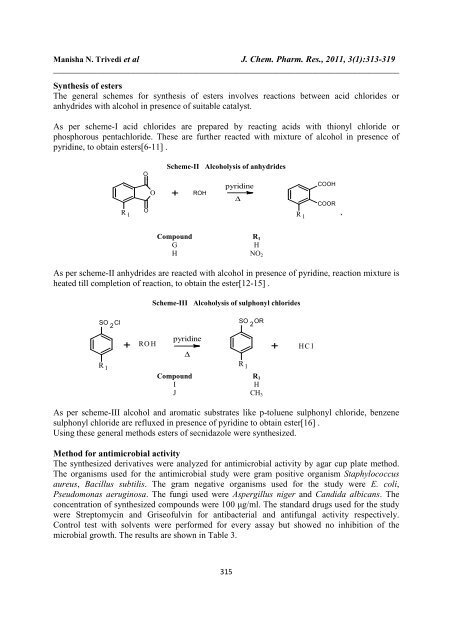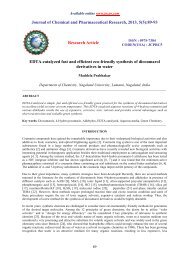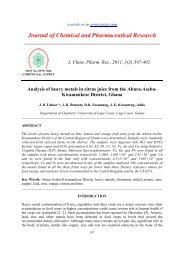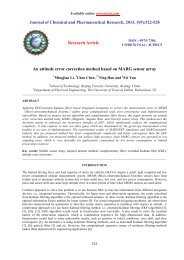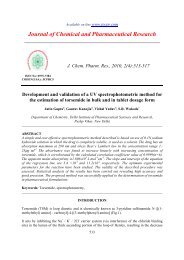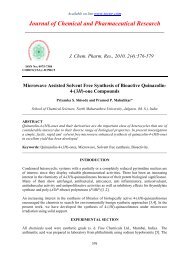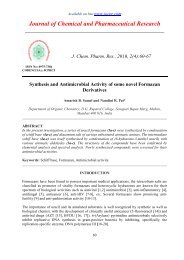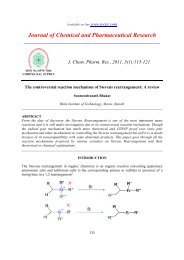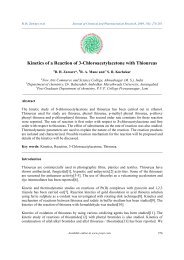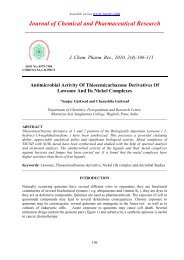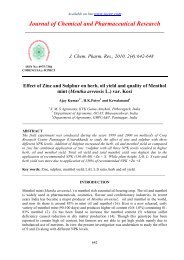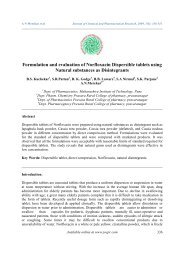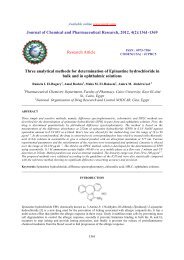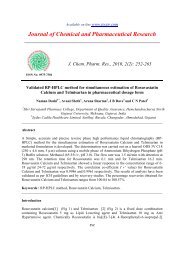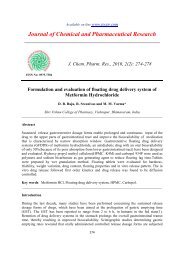Synthesis of some 2-methyl-5-nitroimidazole derivatives - Journal of ...
Synthesis of some 2-methyl-5-nitroimidazole derivatives - Journal of ...
Synthesis of some 2-methyl-5-nitroimidazole derivatives - Journal of ...
You also want an ePaper? Increase the reach of your titles
YUMPU automatically turns print PDFs into web optimized ePapers that Google loves.
Manisha N. Trivedi et al J. Chem. Pharm. Res., 2011, 3(1):313-319<br />
______________________________________________________________________________<br />
<strong>Synthesis</strong> <strong>of</strong> esters<br />
The general schemes for synthesis <strong>of</strong> esters involves reactions between acid chlorides or<br />
anhydrides with alcohol in presence <strong>of</strong> suitable catalyst.<br />
As per scheme-I acid chlorides are prepared by reacting acids with thionyl chloride or<br />
phosphorous pentachloride. These are further reacted with mixture <strong>of</strong> alcohol in presence <strong>of</strong><br />
pyridine, to obtain esters[6-11] .<br />
O<br />
Scheme-II Alcoholysis <strong>of</strong> anhydrides<br />
R 1<br />
O<br />
O<br />
+<br />
ROH<br />
pyridine<br />
∆<br />
R 1<br />
COOH<br />
COOR<br />
`<br />
Compound R 1<br />
G<br />
H<br />
H NO 2<br />
As per scheme-II anhydrides are reacted with alcohol in presence <strong>of</strong> pyridine, reaction mixture is<br />
heated till completion <strong>of</strong> reaction, to obtain the ester[12-15] .<br />
Scheme-III Alcoholysis <strong>of</strong> sulphonyl chlorides<br />
SO 2<br />
Cl<br />
SO 2<br />
OR<br />
pyridine<br />
R 1<br />
+ RO H R 1<br />
∆<br />
+ HC l<br />
Compound R 1<br />
I<br />
H<br />
J CH 3<br />
As per scheme-III alcohol and aromatic substrates like p-toluene sulphonyl chloride, benzene<br />
sulphonyl chloride are refluxed in presence <strong>of</strong> pyridine to obtain ester[16] .<br />
Using these general methods esters <strong>of</strong> secnidazole were synthesized.<br />
Method for antimicrobial activity<br />
The synthesized <strong>derivatives</strong> were analyzed for antimicrobial activity by agar cup plate method.<br />
The organisms used for the antimicrobial study were gram positive organism Staphylococcus<br />
aureus, Bacillus subtilis. The gram negative organisms used for the study were E. coli,<br />
Pseudomonas aeruginosa. The fungi used were Aspergillus niger and Candida albicans. The<br />
concentration <strong>of</strong> synthesized compounds were 100 µg/ml. The standard drugs used for the study<br />
were Streptomycin and Grise<strong>of</strong>ulvin for antibacterial and antifungal activity respectively.<br />
Control test with solvents were performed for every assay but showed no inhibition <strong>of</strong> the<br />
microbial growth. The results are shown in Table 3.<br />
315


